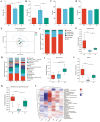Dietary supplementation with dihydroartemisinin improves intestinal barrier function in weaned piglets with intrauterine growth retardation by modulating the gut microbiota
- PMID: 38813622
- PMCID: PMC11222986
- DOI: 10.1093/jas/skae140
Dietary supplementation with dihydroartemisinin improves intestinal barrier function in weaned piglets with intrauterine growth retardation by modulating the gut microbiota
Abstract
The aim of this study was to investigate whether dietary dihydroartemisinin (DHA) supplementation could improve intestinal barrier function and microbiota composition in intrauterine growth restriction (IUGR) weaned piglets. Twelve normal birth weight (NBW) piglets and 24 IUGR piglets at 21 d of age were divided into three groups, which were fed a basal diet (NBW-CON and IUCR-CON groups) and an 80 mg/kg DHA diet (IUGR-DHA group). At 49 d of age, eight piglets of each group with similar body weights within groups were slaughtered, and serum and small intestine samples were collected. The results showed that IUGR piglets reduced growth performance, impaired the markers of intestinal permeability, induced intestinal inflammation, decreased intestinal immunity, and disturbed the intestinal microflora. Dietary DHA supplementation increased average daily gain, average daily feed intake, and body weight at 49 d of age in IUGR-weaned piglets (P < 0.05). DHA treatment decreased serum diamine oxidase activity and increased the numbers of intestinal goblet cells and intraepithelial lymphocytes, concentrations of jejunal mucin-2 and ileal trefoil factor 3, and intestinal secretory immunoglobin A and immunoglobin G (IgG) concentrations of IUGR piglets (P < 0.05). Diet supplemented with DHA also upregulated mRNA abundances of jejunal IgG, the cluster of differentiation 8 (CD8), major histocompatibility complex-I (MHC-I), and interleukin 6 (IL-6) and ileal IgG, Fc receptor for IgG (FcRn), cluster of differentiation 8 (CD4), CD8, MHC-I, IL-6 and tumor necrosis factor α (TNF-α), and enhanced mRNA abundance and protein expression of intestinal occludin and ileal claudin-1 in IUGR piglets (P < 0.05). In addition, DHA supplementation in the diet improved the microbial diversity of the small intestine of IUGR piglets and significantly increased the relative abundance of Actinobacteriota, Streptococcus, Blautia and Streptococcus in the jejunum, and Clostridium sensu_ stricto_in the ileum (P < 0.05). The intestinal microbiota was correlated with the mRNA abundance of tight junction proteins and inflammatory response-related genes. These data suggested that DHA could improve the markers of intestinal barrier function in IUGR-weaned piglets by modulating gut microbiota. DHA may be a novel nutritional candidate for preventing intestinal dysfunction in IUGR pigs.
Keywords: barrier function; dihydroartemisinin; intestine; intrauterine growth retardation; microbiota; piglet.
Plain language summary
Intrauterine growth retardation (IUGR) is defined as the restricted development of the mammalian fetus or its organs during pregnancy, which has high morbidity and mortality during the perinatal period and improves the risk of metabolic diseases in the long term. Dihydroartemisinin (DHA) is a derivative of artemisinin that possesses anti-inflammatory and immunoregulatory effects. Therefore, this experiment was conducted to investigate whether dietary DHA supplementation could improve the intestinal barrier function and microbiota composition in IUGR-weaned piglets. The result showed that IUGR could lead to intestinal barrier dysfunction. Dietary supplementation with DHA improved growth performance and attenuated intestinal barrier dysfunction by decreasing the markers of intestinal permeability, increasing the mucus layer barrier, enhancing immunity, and reducing the inflammatory response in IUGR piglets, which may be attributed to the improvement of the intestinal microbiota. Moreover, the study indicated that the gut microflora was correlated with the gene expression of tight junction proteins and immune function. This study may provide a new nutritional strategy for the maintenance of intestinal health in IUGR pigs.
© The Author(s) 2024. Published by Oxford University Press on behalf of the American Society of Animal Science. All rights reserved. For commercial re-use, please contact reprints@oup.com for reprints and translation rights for reprints. All other permissions can be obtained through our RightsLink service via the Permissions link on the article page on our site—for further information please contact journals.permissions@oup.com.
Conflict of interest statement
The authors declare that they have no competing interests.
Figures









Similar articles
-
Effects of dietary dihydroartemisinin supplementation on growth performance, hepatic inflammation, and lipid metabolism in weaned piglets with intrauterine growth retardation.Anim Sci J. 2020 Jan-Dec;91(1):e13363. doi: 10.1111/asj.13363. Anim Sci J. 2020. PMID: 32219939
-
Dietary dihydroartemisinin supplementation alleviates intestinal inflammatory injury through TLR4/NOD/NF-κB signaling pathway in weaned piglets with intrauterine growth retardation.Anim Nutr. 2021 Sep;7(3):667-678. doi: 10.1016/j.aninu.2020.12.009. Epub 2021 May 3. Anim Nutr. 2021. PMID: 34430721 Free PMC article.
-
Effect of an organic acid blend as an antibiotic alternative on growth performance, antioxidant capacity, intestinal barrier function, and fecal microbiota in weaned piglets.J Anim Sci. 2024 Jan 3;102:skae149. doi: 10.1093/jas/skae149. J Anim Sci. 2024. PMID: 38863369 Free PMC article.
-
Effects of alkaline mineral complex water supplementation on growth performance, inflammatory response, and intestinal barrier function in weaned piglets.J Anim Sci. 2022 Oct 1;100(10):skac251. doi: 10.1093/jas/skac251. J Anim Sci. 2022. PMID: 35913841 Free PMC article.
-
Programming Effects of Maternal Nutrition on Intestinal Development and Microorganisms of Offspring: A Review on Pigs.Microorganisms. 2025 May 17;13(5):1151. doi: 10.3390/microorganisms13051151. Microorganisms. 2025. PMID: 40431323 Free PMC article. Review.
Cited by
-
Connecting Molecular Characteristics of Intrauterine Growth-Retarded Piglets to Targeted Nutritional Interventions: A Review.Animals (Basel). 2025 Jul 29;15(15):2231. doi: 10.3390/ani15152231. Animals (Basel). 2025. PMID: 40805021 Free PMC article. Review.
-
Selenium deficiency modulates necroptosis-mediated intestinal inflammation in broiler through the lncRNAWSF27/miRNA1696/GPX3 axis.J Anim Sci. 2025 Jan 4;103:skae288. doi: 10.1093/jas/skae288. J Anim Sci. 2025. PMID: 39331000
References
-
- Bai, K., Jiang L. Y., Li Q. M., Zhang J. F., Zhang L. L., and Wang T... 2021. Dietary dimethylglycine sodium salt supplementation improves growth performance, redox status, and skeletal muscle function of intrauterine growth-restricted weaned piglets. J. Anim. Sci. 99:skb186. doi: 10.1093/jas/skab186 - DOI - PMC - PubMed
-
- Camara-Lemarroy, C. R., Escobedo-Zúñiga N., Guzmán-de la Garza F. J., Castro-Garza J., Vargas-Villarreal J., and Góngora-Rivera F... 2018. D-Lactate and intestinal fatty-acid binding protein are elevated in serum in patients with acute ischemic stroke. Acta Neurol. Belg. 121:87–93. doi: 10.1007/s13760-018-0940-x - DOI - PubMed
MeSH terms
Substances
LinkOut - more resources
Full Text Sources
Medical
Research Materials

